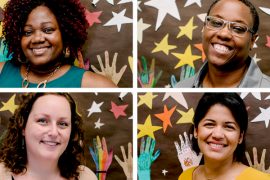By Kathryn Wisniewski
Schisms, reunions, weddings, funerals, wars, births and relocations. Documenting the moments, both high and low, of a family’s history preserves them for the future. Recording family stories in writing produces a tangible piece of the past to share for generations to come.
UW researcher and 2019 BRAVA Woman to Watch Denise Ney co-wrote “Otti Remembers,” her mother’s personal account of growing up in Germany before and after World War II. It took the mother-daughter pair over three years to compose the book.
“I understand my mother in a way that I never would have if we had not done this,” Ney says. “The single thing that I learned about my mom that I didn’t really appreciate before was that she was such a survivor going through everything with World War II and contracting tuberculosis.”
Throughout the process of penning “Otti Remembers,” Ney built a context for her mother’s stories she had heard her whole life, while also uncovering aspects of her mother’s journey that she had never known before.
Though producing the book was time-consuming and, occasionally, tense, Ney is glad she and her mother made the book a reality.
“You have to ask yourself why you’re doing it, and you’re really doing it for the future generations,” Ney says. “The more complete and the more context your story has, the more it will mean for the future generations.”
While Ney and her mother began their project independently and found help along the way, author and writing coach Sarah White created First Person Productions to aid people from start to finish in chronicling their stories.
White says, “Suddenly you realize that the people who came before you are gone, and if you don’t share these stories, they will be forgotten.”
White describes her process as giving people a “DIY approach” to putting together family histories. She uses her expertise and experience to guide writers in creating their own stories.
First Person Productions was born out of White’s background in journalism, marketing and advertising and her desire to do work that was not “all about the money” but was instead “all about the heart.”
When diving into a family history, knowing where to begin can be daunting. “I always tell people to start with the light stuff first,” White says. “Sometimes the thing they’re really burning to do is dive into the trauma. Have fun remembering and reminiscing before diving into the dark corners.”
It can be helpful to start small. Writing a whole book of family history like “Otti Remembers” can seem like a big undertaking but documenting the family goings-on could be as simple as starting a family newsletter you put out once or twice a year.
Ney recommends using multimedia to help document the past and present. Because not everyone is an avid writer, making a video of family members sharing their stories is an easy and dynamic way to preserve history.
Ney had a video made of her mother talking about the stories in “Otti Remembers” and says, “If I had nothing else, I’d want that because that video has captured the individual’s personality. In writing, it’s quite hard to do that.”
If you are planning to dive into a larger project, White suggests starting with two tools. First, she recommends creating a timeline to show the chronology of events in a family’s history. Second, starting with a list of prompting questions can help dig out things you want to know more about.
Jillian Hussey used White’s tips when compiling her own memoir to pass on to her family and friends. From White’s suggestion to use a three-ring binder to organize her work and create a timeline, Hussey put together a narrative of her life, from birth to present.
Though Hussey has yet to land on a title for her memoir, she says she has always thought of the project she knew she would one day write as “A Woman Between Two Worlds,” telling the story of her life as a dual citizen of Australia and the United States.
“That was my hope that I could give my descendants more information about my birth country and how this has be- come my country—my adopted country,” Hussey says. “I am a dual citizen and my children are dual citizens. I think the book does this and does it as plainly and simply as I can.”
No matter what direction you take in documenting your family’s history, the result is a connecting piece that brings together past and present.
“It helps people work through and pass through bad stuff that’s happened and celebrate the good stuff that happens, and most people figure out that the good outweighs the bad,” White says.
In fact, knowing more about family history goes beyond remembering the past.
Bruce Feiler’s 2013 New York Times article “The Stories That Bind Us” explains, “The single most important thing you can do for your family may be the simplest of all: develop a strong family narrative.”
The article outlines a study that created a measure called the “Do You Know?” scale that asked children 20 questions about how much they knew about their family history, such as where their grandparents grew up or how their parents met.
“The more children knew about their family’s history, the stronger their sense of control over their lives, the higher their self-esteem and the more success- fully they believed their families functioned,” Feiler writes.
White sees telling and preserving stories as a way prior generations can help their children and grandchildren without meddling. “You have something to guide you with these family stories,” she says.
For the past 10 years, Agrace Hospice Care has offered their Life Review Program to their patients. The volunteer-based program provides a volunteer to interview a patient and create a book about their life. The book, which can range from five to 55 pages, depending on the patient, is completed with stories and photographs before being given to the patient’s family in print and electronic forms.
The program stemmed from patients and families’ desires to share their life stories.
Karen Wheelock, volunteer coordinator for Agrace, says, “They really find it meaningful to be able to tell their stories and share the memories. Often, they find out that families haven’t heard that story before, and they’ve been able to share pieces of their past that their family doesn’t know about, and a good way to carry on their legacy after they’re gone.”
Wheelock says she sees the Life Review Program as an “extra gift” Agrace is able to give the families of patients.
Marsha Borling has been volunteering for the Life Review Program at Agrace for several years. Her experience as a consultant for hospitals all over the United States to help management under- stand problems with morale gave her experience interviewing and writing down people’s stories.
“I just learned how to do it without a tape recorder and write really fast and not break eye contact,” Borling says. To this day, she does not use a tape recorder for her life review sessions.
Borling meets with people for an average of six to eight sessions that can last an hour to two hours each. When breaking the ice with a new patient, Borling always starts chronologically, asking the simple questions like where the person was born and what their full name is. Often, after a few sessions, Borling doesn’t even need to ask leading questions, and the patient will be ready to share their stories.
Borling writes the life review in the patient’s own voice, telling it in first person as if it were written by the person.
“If you’re writing somebody’s story, it should be their story,” Borling says.
While Borling works with patients in hospice care, she encourages families to document their stories when they can.
“For people who think they want to do this, don’t wait,” Borling says. “It doesn’t have to be at the end of a person’s life.”
“Everyone has a story to tell,” Wheelock says. “A lot of people think that their life isn’t exciting enough to put on paper, but every life review we’ve read has been really unique.”
Ney points to the closing scene of the musical “Hamilton” and the song “Who Lives, Who Dies, Who Tells Your Story” when conveying the importance of documenting family histories. “The point of it,” she says, “is that history is reflective in whoever writes it down. … Do you want to get this right? Do you want to tell your own story? My mom got to tell her own story. These are her words.”




